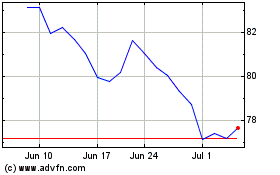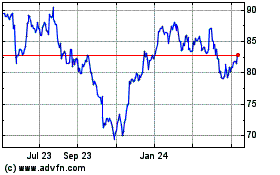Medtronic CoreValve® System Shows Positive Clinical Outcomes in New Patient Populations
October 13 2015 - 9:00AM


New Data Show Low
Mortality and Improved Quality of Life for Patients with Failed
Surgical Aortic Valves, End-Stage Renal Disease and Low Gradient
Aortic Stenosis
DUBLIN and SAN FRANCISCO -
October 13, 2015 - Medtronic plc (NYSE: MDT) today unveiled new
clinical data that showed positive clinical outcomes at one year
for the CoreValve System in new patient populations with
significant co-morbidities. Results from three patient populations
evaluated within the CoreValve® U.S. Expanded Use Study were
presented at the Transcatheter Cardiovascular Therapeutics (TCT)
symposium in San Francisco.
The three populations included patients with a
degenerated surgical bioprosthesis, patients with end-stage renal
disease, and patients with low gradient aortic stenosis. While
transcatheter aortic valve replacement (TAVR) is not approved for
the latter two patient populations, in March, the CoreValve System
was the first transcatheter heart valve approved in the U.S. for
valve-in-valve procedures in both high and extreme risk patients
with failed surgical valves.
"It's encouraging to see patients benefitting from
the CoreValve System, many of whom have been unable to receive
treatment due to these severe comorbidities," said Michael Reardon,
M.D., professor of cardiothoracic surgery at Houston Methodist
DeBakey Heart & Vascular Center, and chairman of the patient
screening committee of the CoreValve U.S. Pivotal Trial. "When
treated with the CoreValve system, not only do these patients live
longer, they are able to achieve and maintain a good quality of
life, which is really important for these individuals and their
loved ones."
VALVE-IN-VALVE
Contributing to CoreValve's first-of-its-kind approval by the U.S.
Food and Drug Administration (FDA) in March 2015 for valve-in-valve
procedures, new data on 109 patients with failed surgical valves in
the Expanded Use Study showed a low rate of all-cause mortality
(13.4 percent) and major stroke (3.1 percent) at one year. These
rates included patients with small surgical valve sizes (17mm inner
diameter) who had not been previously studied. Importantly, all
patients demonstrated a statistically significant improvement in
quality of life as measured by the Kansas City Cardiomyopathy
Questionnaire (KCCQ), with an average improvement of 31.8 at one
year (P < 0.001) on the 100-point scale. Additionally,
93.6 percent of the initial 109 patients were in NYHA class III and
IV at baseline, and in the surviving patients at one year, 73.2
percent were in NYHA Class I.
Patients in the Valve-in-Valve study also
experienced a low rate of moderate aortic regurgitation (6.4
percent) with no cases of severe regurgitation (0.0 percent), and
benefitted from strong hemodynamic performance with a mean gradient
of 16.5mmHg at one year despite placement within small surgical
valves.
"In valve-in-valve procedures, the CoreValve
system's unique supra-annular design helps maximize blood flow
through the aortic valve, which is particularly important when
implanting within a surgical valve where the original orifice area
is often compromised. TAVR provides physicians with an alternative
treatment option for patients facing another open heart surgery,"
continued Dr. Reardon.
END-STAGE RENAL
DISEASE
Another subset from the Expanded Use Study included patients with
end-stage renal disease, who also showed a low rate of mortality
and stroke. Despite the clinical challenges of treating this
patient population, CoreValve exceeded the objective performance
goal for all-cause mortality or major stroke set out in the
original CoreValve Extreme Risk Study (30.3 percent in this
population vs. the objective performance goal of 43 percent in the
US Pivotal ER). Additionally, the rate of all-cause mortality
among the end-stage renal patients in the Expanded Use Study was
lower than that of patients undergoing dialysis in the
Transcatheter Valve Therapy (TVT) Registry (30.3 percent vs. 41
percent). End-stage renal patients also showed a significant
improvement in quality of life at one year with an average increase
in the KCCQ overall summary score of 27.5 points compared to
baseline.
LOW GRADIENT AORTIC
STENOSIS
Findings from the low gradient aortic stenosis (LG-AS) patient
population within the Expanded Use Study were also comparable to
the CoreValve Extreme Risk Study. Patients with LG-AS treated with
the self-expanding valve had a low rate of all-cause mortality or
major stroke whether or not they had LG-AS with normal ejection fraction (26.0 percent for
LG-NEF, N=113) or LG-AS with low ejection
fraction (26.3 percent for LG-LEF, N=46). The KCCQ
score confirmed the patients' improvement in quality of life at one
year with average improvements of 25.8 (LG-NEF) and 30.5 (LG-LEF),
respectively.
The CoreValve System is approved by the FDA for
patients at extreme risk and high risk for surgery. Since
receiving CE (Conformité Européenne) Mark in 2007, the CoreValve
System, and the recently approved CoreValve Evolut R System, has
been implanted in more than 80,000 patients in more than 60
countries. To date, the CoreValve system is not FDA approved for
patients with end stage renal disease or low gradient aortic
stenosis.
In collaboration with leading clinicians,
researchers and scientists worldwide, Medtronic offers the broadest
range of innovative medical technology for the interventional and
surgical treatment of cardiovascular disease and cardiac
arrhythmias. The company strives to offer products and services
that deliver clinical and economic value to healthcare consumers
and providers around the world.
About Medtronic
Medtronic plc (www.medtronic.com), headquartered in Dublin,
Ireland, is among the world's largest medical technology, services
and solutions companies - alleviating pain, restoring health and
extending life for millions of people around the world. Medtronic
employs more than 85,000 people worldwide, serving physicians,
hospitals and patients in more than 160 countries. The company is
focused on collaborating with stakeholders around the world to take
healthcare Further, Together.
Any forward-looking statements
are subject to risks and uncertainties such as those described in
Medtronic's periodic reports on file with the Securities and
Exchange Commission. Actual results may differ materially from
anticipated results.
-end-
Contacts:
Joey Lomicky
Public Relations
+1-763-526-2494
Ryan Weispfenning
Investor Relations
+1-763-505-4626
This
announcement is distributed by NASDAQ OMX Corporate Solutions on
behalf of NASDAQ OMX Corporate Solutions clients.
The issuer of this announcement warrants that they are solely
responsible for the content, accuracy and originality of the
information contained therein.
Source: Medtronic plc via Globenewswire
HUG#1958413
Medtronic (NYSE:MDT)
Historical Stock Chart
From Mar 2024 to Apr 2024

Medtronic (NYSE:MDT)
Historical Stock Chart
From Apr 2023 to Apr 2024
